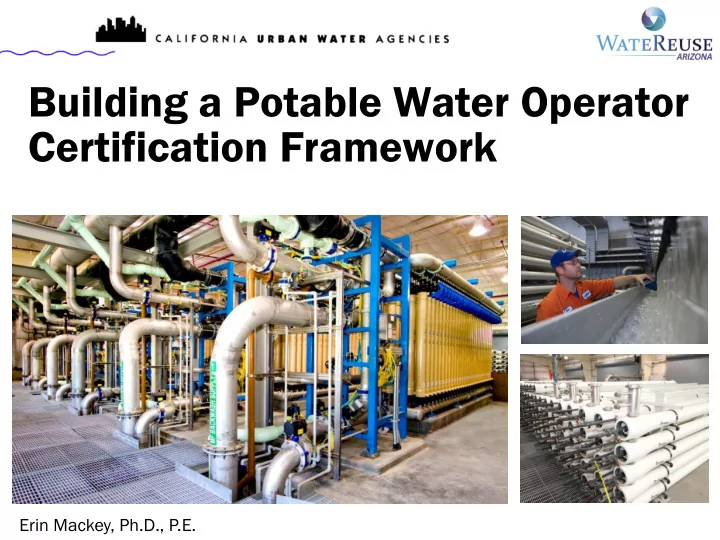

Building a Potable Water Operator Certification Framework Erin Mackey, Ph.D., P.E.
Who is CUWA? Population Served 26 m millio ion n (in 2 2013) 013) Retail Agencies: • Alameda County Water District (ACWD) • East Bay Municipal Utility District (EBMUD) • Los Angeles Department of Water and Power (LADWP) Retail/Wholesale Agencies: • Contra Costa Water District (CCWD) • City of San Diego (San Diego) • San Francisco Public Utilities Commission (SFPUC) Wholesale Agencies: • Metropolitan Water District of Southern California (MWDSC) • Santa Clara Valley Water District (SCVWD) • San Diego County Water Authority (SDCWA) • Zone 7 Water Agency (Zone 7) 2
CUWA’s Mission EBMUD Mokelumne Aqueduct “To provide a forum for combining the expertise and resources of its member agencies to advance reliable high-quality water supplies for the State’s current and future urban water needs in a cost- effective manner for the public, the environment and the economy.” 3
Training of potable reuse operators is critical to maintain high-quality reuse supplies protective of public health. Certification gives utilities, regulators and the public confidence that staff is qualified to operate potable reuse systems. Brown and Caldwell 4
Existing exams do not cover advanced water treatment or potable reuse concerns • More robust treatment train • Unique O&M • Enhanced risk 5
CUWA developed a white paper as a collaborative effort with several partners • Step 1: Literature review and survey to establish understanding of existing programs and knowledge gaps • Step 2: Facilitated workshop to gain consensus on a framework for potable reuse operator training and certification • Step 3: Finalize white paper 6
Current Certification Practices
Current CA Operator Certification Program requirements Meet minimum experience and 1 education requirements 2 Pass a written test 3 Apply for certification 8
Wastewater Operator Certification Program 1 track 5 levels • 5 Grade levels (treatment & collection) Drinking Water Operator Certification Program 2 tracks 5 levels • Inside the fence • 5 T-grade levels (water treatment) • Outside the fence • 5 D-grade levels (distribution) 9
Gaps in Operator Skill Needs
When permitted in California, potable reuse systems are expected to use robust advanced treatment trains with multiple unit processes 11
Levels of Water Reuse Treatment Brown and Caldwell 12
Advanced water treatment processes used in potable reuse Soil aquifer treatment (SAT) Ozone and biologically active carbon Membrane filtration Reverse osmosis UV/AOP 13
On-the-job training is the primary means of gaining potable reuse advanced treatment system expertise Substantial on-the-job learning Moderate on-the-job 16 16% learning Minimal on-the-job learning 13% 71 71% Source: WateReuse California Utility Survey, 2015 14
Possible Paths Forward
A recent survey helped identify the gaps utilities see in operator certification with respect to potable reuse systems 70% of survey respondents agree that one certification process for all potable reuse water types should be developed Source: WateReuse California Utility Survey, 2015 Brown and Caldwell 16
Separate Potable Reuse Operator 1 Certification Brown and Caldwell 17
Potable Reuse or AWT Operator 2 & 3 Certification Supplement OR OR WW-OCP Supplement W-OCP Supplement Brown and Caldwell 18
Potable Reuse or AWT Hybrid 4 Supplement Brown and Caldwell 19
Workshop Outcomes and Subsequent Framework
Industry stakeholders agreed on Option #4 21
Strategic Recommendations for an Industry- Supported Framework 22
Foundational Needs • Fielding enough candidates • Facilitating program development (i.e., speed) • Acceptance by regulators/utilities/operators • Testable • Led by association(s) • Financially viable 23
Focus on the Following Advanced Processes Ozone and biologically active carbon (BAC) Membrane filtration (MF/UF) Reverse osmosis (RO) UV/AOP 24
Critical Unsettled Issues 1. An AWT Program or a Potable Reuse Program? 2. Who’s going to develop it?* 3. Who’s going to pay for it? 4. Sufficient training programs are necessary to ensure potential candidates have the knowledge they need to pass the test. 5. Legislation and/or an update to the operator certification regulations will likely be needed to address the proposed new certification requirements. 25
Next Steps • Program development and implementation. o An entity or entities will need to commit to developing training and certification programs for an AWT or PR supplement. AWWA CA-NV is leading an effort that CWEA has now engaged in as well. o Allows Office of Operator Certification to create a program. • Curriculum development: o WateReuse Research Foundation (WRRF 15-05) – Developing DPR curriculum is on-going. • Continued engagement with the DDW and OOC on development of a regulatory framework for potable reuse. Brown and Caldwell 26
Questions? The white paper is available for download at the CUWA website (www.cuwa.org)
Recommend
More recommend